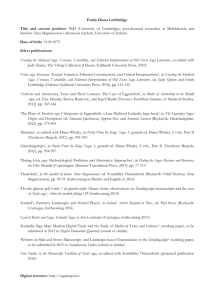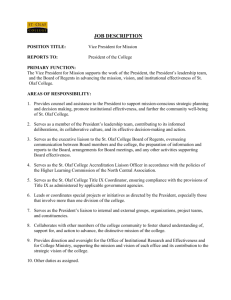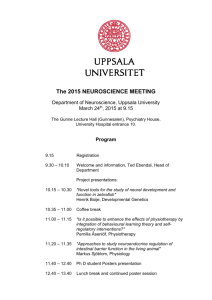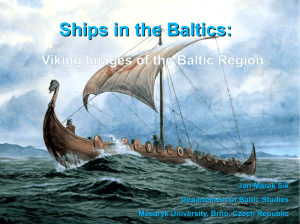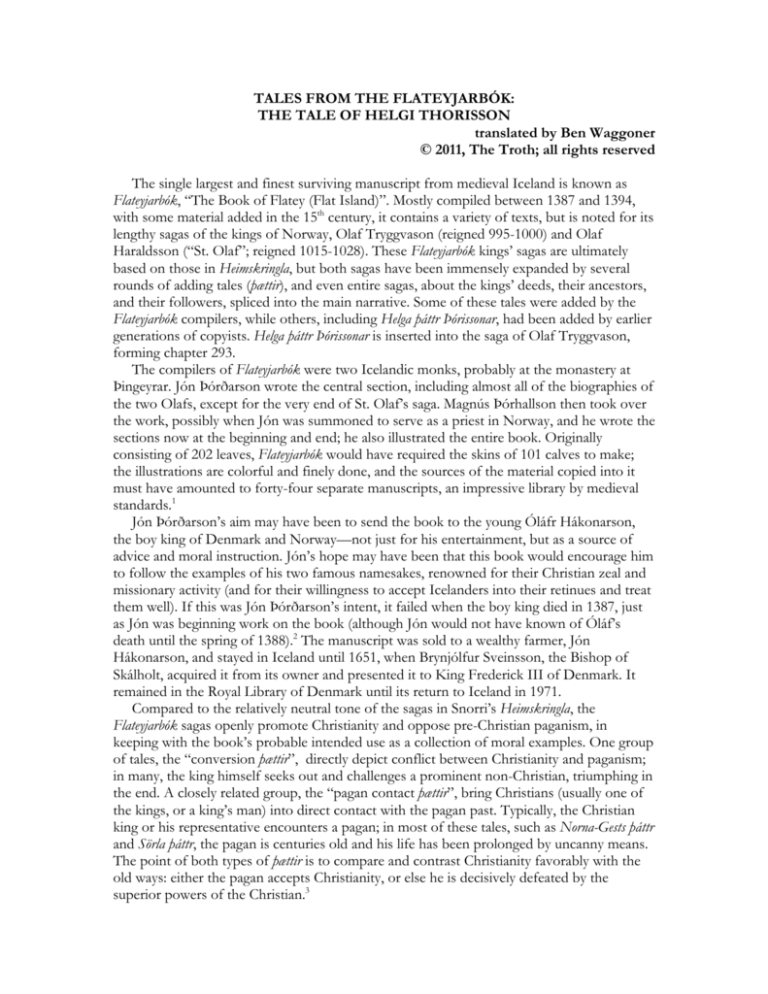
TALES FROM THE FLATEYJARBÓK:
THE TALE OF HELGI THORISSON
translated by Ben Waggoner
© 2011, The Troth; all rights reserved
The single largest and finest surviving manuscript from medieval Iceland is known as
Flateyjarbók, “The Book of Flatey (Flat Island)”. Mostly compiled between 1387 and 1394,
with some material added in the 15th century, it contains a variety of texts, but is noted for its
lengthy sagas of the kings of Norway, Olaf Tryggvason (reigned 995-1000) and Olaf
Haraldsson (“St. Olaf”; reigned 1015-1028). These Flateyjarbók kings’ sagas are ultimately
based on those in Heimskringla, but both sagas have been immensely expanded by several
rounds of adding tales (þættir), and even entire sagas, about the kings’ deeds, their ancestors,
and their followers, spliced into the main narrative. Some of these tales were added by the
Flateyjarbók compilers, while others, including Helga þáttr Þórissonar, had been added by earlier
generations of copyists. Helga þáttr Þórissonar is inserted into the saga of Olaf Tryggvason,
forming chapter 293.
The compilers of Flateyjarbók were two Icelandic monks, probably at the monastery at
Þingeyrar. Jón Þórðarson wrote the central section, including almost all of the biographies of
the two Olafs, except for the very end of St. Olaf’s saga. Magnús Þórhallson then took over
the work, possibly when Jón was summoned to serve as a priest in Norway, and he wrote the
sections now at the beginning and end; he also illustrated the entire book. Originally
consisting of 202 leaves, Flateyjarbók would have required the skins of 101 calves to make;
the illustrations are colorful and finely done, and the sources of the material copied into it
must have amounted to forty-four separate manuscripts, an impressive library by medieval
standards.1
Jón Þórðarson’s aim may have been to send the book to the young Óláfr Hákonarson,
the boy king of Denmark and Norway—not just for his entertainment, but as a source of
advice and moral instruction. Jón’s hope may have been that this book would encourage him
to follow the examples of his two famous namesakes, renowned for their Christian zeal and
missionary activity (and for their willingness to accept Icelanders into their retinues and treat
them well). If this was Jón Þórðarson’s intent, it failed when the boy king died in 1387, just
as Jón was beginning work on the book (although Jón would not have known of Óláf’s
death until the spring of 1388).2 The manuscript was sold to a wealthy farmer, Jón
Hákonarson, and stayed in Iceland until 1651, when Brynjólfur Sveinsson, the Bishop of
Skálholt, acquired it from its owner and presented it to King Frederick III of Denmark. It
remained in the Royal Library of Denmark until its return to Iceland in 1971.
Compared to the relatively neutral tone of the sagas in Snorri’s Heimskringla, the
Flateyjarbók sagas openly promote Christianity and oppose pre-Christian paganism, in
keeping with the book’s probable intended use as a collection of moral examples. One group
of tales, the “conversion þættir”, directly depict conflict between Christianity and paganism;
in many, the king himself seeks out and challenges a prominent non-Christian, triumphing in
the end. A closely related group, the “pagan contact þættir”, bring Christians (usually one of
the kings, or a king’s man) into direct contact with the pagan past. Typically, the Christian
king or his representative encounters a pagan; in most of these tales, such as Norna-Gests þáttr
and Sörla þáttr, the pagan is centuries old and his life has been prolonged by uncanny means.
The point of both types of þættir is to compare and contrast Christianity favorably with the
old ways: either the pagan accepts Christianity, or else he is decisively defeated by the
superior powers of the Christian.3
Helga þáttr Þórissonar should be classified as one of the “pagan contact þættir”,4 but in
several ways it is different from the typical ones. King Olaf Tryggvason’s contact with
paganism is not with someone from a distant time, but with someone from a distant space:
the representatives of the legendary Gudmund of Glæsisvellir (“Amber Plains” or “Shining
Plains”), who lives somewhere in the far north, in or near Jötunheim the realm of the giants,
somewhere in or beyond Bjarmaland, the coast of the White Sea. Gudmund appears in
several legendary sagas, and also in Saxo’s History of the Danes. In Saxo’s History, the earliest
surviving source, he is the brother of the giant Geruth (Geirrod) and presumably a giant
himself, whereas in Þórsteins saga bæjarmagns he is a vassal of Geirrod, and though huge, is
different from Geirrod and other jötnar or giants.5 In Hervarar saga, Gudmund and his kin are
extremely long-lived, and their realm is said to include Ódáinsakr (Field of the Undying), a
land without aging or death6; whereas in History of the Danes, his realm includes a river that
separates the world of men from a world of monsters which no man can enter, and in
Þórsteins saga bæjarmagns his realm is bordered by a cold river that instantly freezes the flesh of
any human it touches.7 Gudmund is friendly to the human hero of Þórsteins saga bæjarmagns,
but in other sources he is more sinister. According to Saxo, anyone who eats his food loses
his memory and is doomed to live among giants and monsters; one man who falls in love
with one of his daughters loses his mind and ends up being swallowed up by the earth when
he tries to leave.8 In Bósa saga he is a powerful enemy, although the heroes end up getting the
better of him by their superior strength and guile.9
Gudmund is never seen directly in Helga þáttr Þórissonar, but he and his people are
depicted as treacherous and wicked, despite their magnificence and generosity. Their
depiction in Helga þáttr Þórissonar is more like Saxo’s History of the Danes than the more comic
Bósa saga or Þórsteins þáttr bæjarmagns. Hervarar saga claims that Gudmund was worshipped as
divine, although there seems to be no independent evidence for a historical cult.
Nonetheless, it seems clear that Gudmund was fairly widely known in the old mythology,
although his nature and role in pagan belief is not clear. The writer of Helga þáttr Þórissonar
chose a well-known figure to contrast with King Olaf Tryggvason, emphasizing Gudmund’s
sinister aspects to bring out King Olaf’s holiness.
All the same, Olaf’s victory is limited. While he wins the drinking horns and fends off evil
enchantments by the power of his bishop’s prayers, he cannot save his retainer from
blindness and early death—to say nothing of destroying Gudmund or forcing him to
convert. Rowe notes that in Flateyjarbók, Helga þáttr Þórissonar immediately follows another
“pagan contact þáttr”, Norna-Gests þáttr, which presents an exemplary pagan who had served
with the greatest heroes of the pagan past, such as Ragnar Lodbrok and Sigurd the Volsung.
King Olaf Tryggvason, and by extension the reader, found much to admire about these
noble pagans. Helga þáttr Þórissonar may have been deliberately paired with Norna-Gests þáttr as
a reminder that the old ways had a dark and dangerous side. While the “dark side” did not
negate or undermine the glories of the past, it was in no way worthy of Christians’
admiration.10
The Flateyjarbók scribes, and those who wrote the sources that they drew on, had no
intention of presenting the old ways fairly or accurately. To put it simply, they were monks
and priests—not journalists or anthropologists. They had understandable motives for
framing the stories in the ways that they did, reworking older legends for their own purposes
and in accordance with their own religious faith. Nonetheless, they preserved a great treasure
trove of old lore. With careful scholarship, we Heathens can learn to remove some of the
Christian worldview implicit in these tales, and recover what they must once have meant.
I have translated this tale from the text published in Fornaldarsögur Norðurlanda, freely
available at http://www.heimskringla.no/wiki/Helga_þáttr_Þórissonar .
CHAPTER I
There was a man named Thorir who lived in Norway on the farm named Raudaberg.
This farm is a short distance from Viken.11 Thorir had two sons. One was named Helgi, and
the other was Thorstein. Both of them were well-mannered men, but Helgi was more
accomplished. Their father was a hersir12 in rank. He was a friend of King Olaf.
One summer, the brothers made a trading journey north to Finnmark; they had butter
and bacon to trade with the Finns. They had a successful journey and set out for home
towards the end of summer. One day they came to the cape called Vimund. There was a
splendid forest there. They went on land and cut some maples. Helgi went farther into the
forest than the other men. Suddenly a great darkness came up, so that he couldn’t find their
ship before evening, and night began falling quickly.
Then Helgi saw twelve women riding out of the forest. They were all on red horses and
wearing red riding clothes. They dismounted. All of the horses’ harnesses were gleaming
with gold. One of these women excelled all the others in beauty, and all the others served
her, this imposing woman. Their horses went to graze. After that, they set up a beautiful
tent. It was striped with various colors and shot through all over with gold, and all the heads
of the poles which held up the tent were made of gold, and so was the center pole, with a
great golden knob on top. When they had pitched the tent, they set up a table and brought
many kinds of delicacies. Then they began to wash their hands, with a pitcher and washbasins made of silver, and everything inlaid with gold.13
Helgi stood close to their tent and turned to look at it. The woman who led them said,
“Helgi, come here and have food and drink with us.” He did so. Helgi saw that there were
excellent drink and other foods, and beautiful vessels. Then the table was taken away and
beds were prepared, and they were much more splendid that the bed of anyone else.
The woman who excelled all the rest asked Helgi whether he would prefer to sleep alone,
or next to her. Helgi asked her name. She answered, “My name is Ingibjorg, the daughter of
Gudmund of Glaesisvellir.”
Helgi said, “I’d like to sleep with you.”
And so they did, for three nights continually. Then the weather was clear. They stood up
and dressed. Then Ingibjorg said, “Now we two must part here. Here are two small chests,
which I will give you. One is full of silver, and the other is full of gold. Tell no one where
they come from.”
After that the women rode away by the same way they had come, and he went to his ship.
His men welcomed him warmly and asked where he had been staying, but he didn’t want to
say anything about it. They set sail southwards, along the coast, and came home to his father.
They had earned a great deal of money. The father of Helgi and his brother asked how such
riches as he had in the chests had come to him, but he didn’t want to tell.
CHAPTER II
Now time passed until Yule. One night, an ominous wind sprang up. Thorstein said to
his brother, “We two should get up and find out what’s passing by our ship.” They did so,
and it was quite secure. Helgi had had a dragon’s head made, up on the prow of their ship,
and he had it fixed well above the waterline. The money that King Gudmund’s daughter
Ingibjorg had given him had gone for this, and some of it he enclosed in the dragon’s neck.
Then they heard a great crash. Two men rode at them and dragged Helgi away with them.
Thorstein didn’t know what had become of him. The wind quickly died down. Thorstein
came home and told his father what had happened, and it seemed to be terrible news. He
went at once to meet King Olaf, and he told him what had happened, and begged him to
find out where his son had disappeared to. The king said that he would do as he asked, yet
he said that he couldn’t say with certainty whether Helgi would be of any use to his kinfolk.
Then Thorir went home, and so the year passed until the next Yule. The king stayed at
Alrekstad14 that winter. Then came the eighth day of Yule, and in the evening, three men
came into the hall before King Olaf, where he sat at the table. They greeted him well. The
king greeted them well in return. Helgi had come, but men didn’t recognize the other two.
The king asked them their names, and each of them said that he was named Grim.15 “We
have been sent here to you by Gudmund of Glæsisvellir. He sends you his greetings, and
two horns along with them.”
The king accepted them. They were worked with gold and were splendid treasures. King
Olaf had two horns that were called the Hyrnings,16 but though they were quite good, these
that Gudmund had sent him were even better. “King Gudmund asks this of you, lord: that
you and your men should be his friends. Having your goodwill is of great worth to him,
more so than that of all other kings.”
The king didn’t answer that, but had them shown to their seats. The king had the horns
of the Grims filled with good drink, and had the bishop bless them, and had them brought
to the Grims so that they should be the first to drink from them. Then the king spoke this
verse:
The guests in turn
must take the horns,
as Gudmund’s thanes
get time to rest
and drink their draughts
from dear namesakes;
the ale shall prove good
for the Grims today.
The Grims accepted the horns, and realized what the bishop had spoken over the drink.
They said, “Our King Gudmund’s guesses weren’t far off. This king is deceitful and knows
how to reward good with evil,17 for our king showed him honor. Let’s all get up now and get
away from here.”
So they did. There was a great commotion in the room. They flung the drink out of the
horns and put out the fire. Then everyone heard a loud crash. The king asked God for
protection, and ordered his men to stand up and stay calm before this uproar. At once the
Grims went outside, and Helgi went with them. A light was kindled in the king’s hall. They
saw three men killed, but there lay the Grims’ horns on the floor, next to the dead men.
“This is a great wonder,” said the king, “and it would be better for such things to happen
seldom. I have heard it said about Gudmund of Glæsisvellir that he is a great sorceror and it
can be especially bad to deal with him, and the men who are under his power are in a bad
fix, even if we could do something.”
The king had the Grims’ horns kept and drunk from, and they served well. The route that
the Grims took from the east to Alreksstad is now called Grims’ Pass, and no one has gone
that way since then.
CHAPTER III
Now a year passed, and the eighth day of Yule came again, and the king and his retainers
were in church to hear Mass. Three men came to the church doors, and one stayed behind.
The other two went away, but first they said, “Here we’ve brought you Sulky, king, but it’s
not certain when you’ll get rid of him.” The people recognized that it was Helgi there. The
king went to his feasting, and when men spoke with Helgi, they realized that he was blind.
The king asked what his condition meant, and where he had been all this time. He first
told the king about how he encountered the women in the forest, and then about how the
Grims sent the storm at the brothers when they wanted to save the ship. Then the Grims
had taken him with them to Gudmund of Glæsisvellir and brought him to Ingibjorg,
Gudmund’s daughter.
Then the king said, “How did being there seem to you?”
“Perfectly good,” he said, “I’ve never known better.”
Then the king asked about King Gudmund’s customs, and about his subjects and deeds.
He spoke well of everything, and said that they were far greater than he could count.
The king said, “Why did you go away so quickly the previous winter?”
“King Gudmund sent the Grims to deceive you,” he said, “and because of your prayers,
he let me go free, so that you might know what had become of me. But the reason we went
away so quickly the last time was that the Grims didn’t have the sort of nature that they
could drink that drink which you had blessed. They became angry when they realized that
they were beaten, and they killed your men because King Gudmund had told them to, if they
couldn’t do any harm to you. But he showed his own high rank by sending you the horns, so
that you would remember less to seek for me.”
The king asked, “Why have you come away for a second time?”
He answered, “Ingibjorg caused that. She felt that she couldn’t lie with me except with
discomfort, if she came against me naked, and mostly for that reason I went away. And King
Gudmund didn’t want to oppose you as soon as he found out that you wanted to take me
away. But about the high estate and munificence of King Gudmund, and about the great
multitude of men with him, I cannot tell in few words.”
The king asked, “Why are you blind?”
He answered, “Gudmund’s daughter Ingibjorg ripped both my eyes out when we parted.
She said that the women in Norway wouldn’t enjoy me for long.”
The king said, “Gudmund would deserve harm from me for the killings that he did, if
God wills it so.”
Helgi’s father Thorir was sent for at once, and he thanked him well that his son had come
back out of the hands of the trolls. He then went home, but Helgi stayed behind with the
king, and lived until the same time next year. The king had the Grims’ horns with him when
he sailed out from land for the last time. People say that when King Olaf disappeared from
the Long Serpent,18 the horns also disappeared, and no one has seen them since. And here we
leave off telling about the Grims.
BOOK-HOARD
Harris, Joseph. “Folktale and Thattr: The Case of Rognvald and Raud.” Folklore Forum, vol.
13 (1980), pp. 158-198.
McKinnell, John. Meeting the Other in Norse Myth and Legend. Cambridge: D. S. Brewer, 2005.
Pálsson, Hermann, and Paul Edwards, transl. Seven Viking Romances. Harmondsworth:
Penguin, 1985.
Power, Rosemary. “Le Lai de Lanval and Helga þáttr Þórissonar.” Bibliotheca Arnamagnæana, vol.
38: Opuscula VIII (1985), pp. 158–61.
Rowe, Elizabeth Ashliman. “Þorsteins þáttr bæjarmagns, Helga þáttr Þórissonar, and the
Conversion Þættir.” Scandinavian Studies, vol. 76, no. 4 (2004), pp. 459-474.
—. The Development of Flateyjarbók: Iceland and the Norwegian Dynastic Crisis of 1389. Odense:
University Press of Southern Denmark, 2005.
Saxo Grammaticus. The History of the Danes: Books I-IX. Ed. Hilda R. Ellis-Davidson, trans.
Peter Fisher. Rochester, N.Y.: D.S. Brewer, 1996.
Tolkien, Christopher, transl. The Saga of King Heidrek the Wise. London: Thomas Nelson,
1960.
1
Rowe, Development of Flateyjarbók, pp. 11-16.
Rowe, Development of Flateyjarbók, pp. 23-25.
3
Harris, “Folktale and Thattr”, pp. 162-167.
4
Rowe, “The Conversion Þættir,” pp. 465-471.
5
Þórsteins saga bæjarmagns ch. 5, transl. Pálsson and Edwards, Seven Viking Romances, pp. 263265.
6
transl. Tolkien, The Saga of King Heidrek the Wise, pp. 66, 84-86.
7
Pálsson and Edwards, p. 264.
8
History of the Danes VIII, transl. Ellis-Davidson and Fisher, pp. 263-267.
9
Bósa saga chs. 8-16, transl. Pálsson and Edwards, pp. 211-227.
10
Rowe, “The Conversion Þættir,” pp. 468-471.
11
Viken (Vík in Norse) is the present-day Oslofjord.
12
A hersir was a local chieftain and military commander, of lesser rank than a jarl.
13
A stag-hunt that leads the hunter to an otherworldly lady appears in other sagas (e.g.
Göngu-Hrólfs saga ch. 15) and is known in various folktales and legends such as the British
legend of Thomas the Rhymer (Pálsson and Edwards, p. 12). The direct source here is
probably Lanval, one of the courtly lais of Marie de France, in which the mysterious lady is a
fée or “fairy”. Lanval was translated into Old Norse as Januals ljóð, in the collection of lais
known as Strengleikar. (Power, “Le Lai de Lanval”, pp. 158-161; McKinnell, Meeting the Other,
p. 177)
14
A large royal estate on the Norwegian west coast; now the Årstad district of the city of
Bergen.
15
Grímr means “Mask”; in the sagas, it’s a fairly common name given by one who is
disguised or not inclined to reveal his actual name (e.g. Völsa þáttr).
2
16
The story of how Olaf got the Hyrnings is told in Þórsteins saga bæjarmagns; they are also
associated with Gudmund of Glæsisvellir, and Þórsteins saga and Helga þáttr may in fact
contain doublets of the same motif.
17
An ironic allusion to Psalms 109:5 in the Bible: “And they have rewarded me evil for good,
and hatred for my love.”
18
The Long Serpent was Olaf Tryggvason’s flagship. Defeated at the naval Battle of Svold in
the western Baltic, the king is said to have leaped into the sea.


